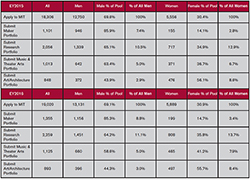
| Vol.
XXIX No.
1 September / October 2016 |
| contents |
| Printable Version |
An Update on Gender Imbalance
in MIT Admissions Maker Portfolios
Last November, we recorded in these pages a notable difference in the rates at which men and women submitted Maker Portfolios as supplements to their freshman applications. Specifically, we observed that women submitted the Maker Portfolio – and only the Maker Portfolio – at a lower rate than men, and far below the rates that they submit any other type of supplemental portfolio or apply to MIT overall. We solicited advice from readers and took additional steps to increase the representation of women and the diversity of projects featured in public presentations and portfolio materials.
After another admissions cycle, we regret to report that the patterns have not changed much. Below is the data for the prospective Class of 2019 (entering fall 2015) that we published last year, and the data for the prospective Class of 2020 (entering fall 2016).
As shown in the figure above, the gap between the proportion of men and women who submitted Maker Portfolios closed by .6%, and the rate at which female applicants submitted Maker Portfolios increased by .6%, shifts that closely track the .5% delta in overall application rates. Indeed, portfolio submission rates increased across all portfolios for both men and women. Any improvement is a good thing, but it's a bit discouraging that, despite efforts to better represent the diversity of people and projects we wish to encounter in the Maker Portfolio, the needle hasn't moved as much as we would like.
As we approach the next admissions cycle, the Admissions Office is continuing to work on improving representation and recruitment, including an initiative, in partnership with Maker Media, that will leverage their intellectual property and community of Maker Faires with admissions' database of prospective students to help encourage more women to take up “making” and identify as makers. However, the persistence of this pattern, despite several years of prior work to improve representation and reach targeted populations, leaves us questioning what other dynamics may be in play. Our understanding would probably be improved by additional qualitative work, including (but not limited to) interviews with enrolling women who did or did not submit maker portfolios and other fieldwork that might trace the web of reasons that influence whether and which portfolios are submitted by applicants. We welcome suggestions of resources (e.g., people and/or money) that might support this kind of research to: chris.peterson@mit.edu, cc:ing hal@mit.edu.
| Back to top | |
| Send your comments |
| home this issue archives editorial board contact us faculty website |
